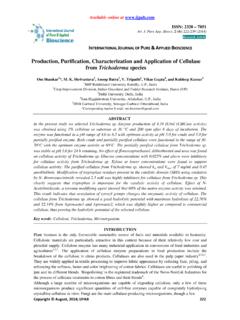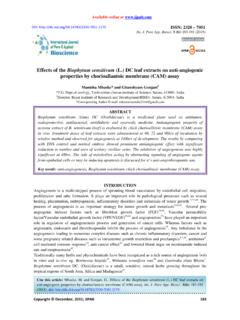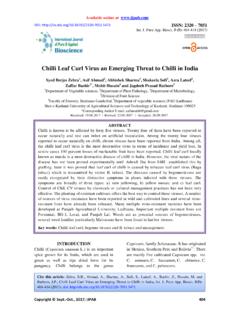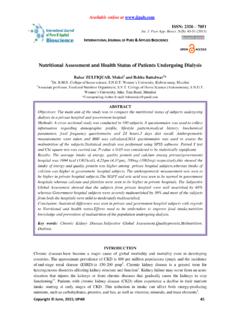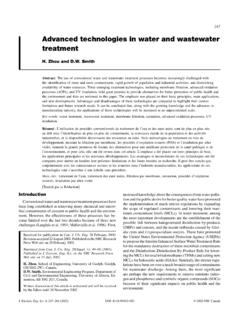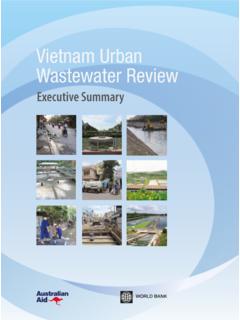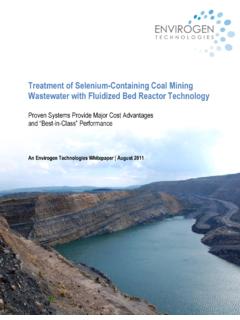Transcription of Microbial Roles and Dynamics in Wastewater …
1 Available online at ISSN: 2320 7051. Int. J. Pure App. Biosci. 2 (1): 156-168 (2014). Review Article International Journal of Pure & Applied Bioscience Microbial Roles and Dynamics in Wastewater Treatment Systems: An Overview Akpor OB1*, Ogundeji MD1,Olaolu TD2and Aderiye BI3. 1. Microbiology Unit, Department of Biological Sciences, Landmark University, OmuAran, Kwara State, Nigeria 2. BiochemistryUnit, Department of Biological Sciences, Landmark University, OmuAran, Kwara State, Nigeria 3. Department of Microbiology, Ekiti State University, Ado Ekiti, Ekiti State, Nigeria *Corresponding Author E-mail: _____. ABSTRACT. The quality of Wastewater effluents is responsible for the degradation of receiving water bodies, such as lakes, rivers, streams.
2 The two main processes for the removal of impurities from Wastewater influents are chemical and biological treatment but due to some drawbacks of the chemical treatment, biological treatment is now employed. Microorganisms are of major importance in industrial Wastewater treatment, agricultural and aquaculture. They reside in the sediment and other substrates, and in the water of aquaculture facilities. Microorganisms may have positive or negative effects on the outcome of aquaculture operations. Positive Microbial activities include elimination of toxic materials such as ammonia, nitrite, and hydrogen sulfide, degradation of uneaten feed, and nutrition of aquatic animals such as shrimp, fishes.
3 These and other functions make microorganisms the key players in the health and sustainability of aquaculture. The role of the different Microbial groups present in the waste water treatment systems with particular importance of bacteria and protozoa in the removal process of nitrogen and phosphorus indicate that the biological treatment system is very effective in the Wastewater treatment systems. Keywords: Wastewater Treatment Systems, Microorganisms, protozoa, bacteriophages. _____. INTRODUCTION. The major Microbial populations found in Wastewater treatment systems are bacteria, protozoa, viruses, fungi, algae and helminthes.
4 The presence of most of these organisms in water leads to spread of diseases1. The majority of waterborne microorganisms that cause human disease come from animal and human fecal wastes. These contain a wide variety of viruses, bacteria, and protozoa that may get washed into drinking water supplies or receiving water bodies2. Microbial pathogens are considered to be critical factors contributing to numerous waterborne outbreaks. Many Microbial pathogens in Wastewater can cause chronic diseases with costly long-term effects, such as degenerative heart disease and stomach ulcer. The density and diversity of these pollutants can vary depending on the intensity and prevalence of infection in the sewered community.
5 The detection, isolation and identification of the different types of Microbial pollutants in Wastewater are always difficult, expensive and time consuming. To avoid this, indicator organisms are always used to determine the relative risk of the possible presence of a particular pathogen in wastewater3. Viruses are among the most important and potentially most hazardous pollutants in Wastewater . They are generally more resistant to treatment, more infectious, more difficult to detect and require smaller doses to cause infections4,5. Because of the difficulty in detecting viruses, due to their low numbers, bacterial viruses (bacteriophages) have been examined for use in faecal pollution and the effectiveness of treatment 156.
6 Akpor, OB et al Int. J. Pure App. Biosci. 2 (1): 156-168 (2014) ISSN: 2320 7051. processes to remove enteric viruses. Bacteria are the most common Microbial pollutants in Wastewater . They cause a wide range of infections, such as diarrhea, dysentery, skin and tissue infections, etc. Disease-causing bacteria found in water include different types of bacteria, such as E. coli O157:H7;. Listeria sp., Salmonella sp., Leptosporosis sp., etc (CDC, 1997). The major pathogenic protozoans associated with Wastewater are Giardia sp. and Cryptosporidium are more prevalent in Wastewater than in any other environmental source6,4. The two major chemical pollutants in Wastewater are nitrogen and phosphorus.
7 Although there are other chemical pollutants, such as heavy metals, detergents and, pesticides, however nitrogen and phosphorus are the most frequent limiting nutrients in eutrophication7,8. The processes for the removal of impurities in Wastewater can be divided into two: chemical and biological. Chemical removal is a method of Wastewater treatment in which chemicals are added to form particles which settle and remove contaminants. The treated water is then decanted and appropriately disposed of or reused after the resultant sludge is dewatered to reduce the volume. The most common techniques in chemical treatment are coagulation/flocculation, chlorination, chloramination, ozonation and ultraviolet light (UV)9,10.
8 All biological-treatment processes take advantage of the ability of microorganisms to use diverse Wastewater constituents to provide the energy for Microbial metabolism and the building blocks for cell synthesis. This metabolic activity can remove contaminants that are as varied as raw materials and by-products11. The aim of this paper was to review the various Wastewater treatment systems and examine the Roles and Dynamics of the various microorganisms that are found in Wastewater treatment systems. Biological Wastewater Treatment Systems The fundamental reason for the treatment of Wastewater is to circumvent the effect of pollution of water sources and protect public health through the safeguarding of water sources against the spread of diseases.
9 This is carried out through a variety of treatment systems, which could be onsite treatment systems or offsite treatment systems. This section is therefore aimed at describing the offsite (activated sludge, trickling filters, stabilization ponds, constructed wetlands, membrane bioreactors) Wastewater treatment systems12. Activated sludge The activated sludge is a process that has to do with high concentration of microorganisms, basically bacteria, protozoa and fungi, which are present as loose clumped mass of fine particles that are kept in suspension by stirring, with the aim of removing organic matter from wastewater13. An activated sludge can also be referred to as sewagethat contains active microorganisms which helps in the breakdown of organic matter.
10 It is the most versatile and effective of all the Wastewater treatment systems. In an activated sludge system, the microorganisms present in the aeration tank can breakdown the organic matter present in the Wastewater . The microorganisms are composed of 70-90 % organic matter and 10-30. % inorganic matter. The types of cells vary, depending on the chemical conditions and the specific characteristics of the organisms in the biological mass14. After the mixed liquor is discharged from the tank, a clarifier (also referred to as a settling or sedimentation tank) separates, by gravity the suspended solids from the treated Wastewater .
